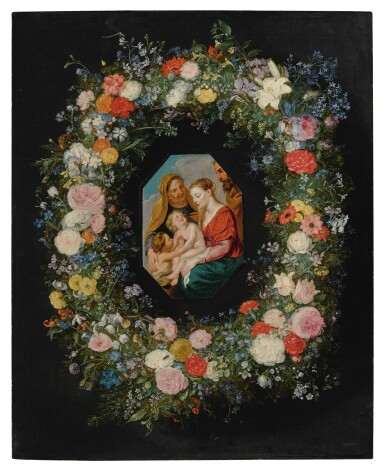Master Paintings Part II
Master Paintings Part II

Property from a Private Collection
Jan Brueghel the Elder and Workshop
Holy Family within a floral garland
Lot Closed
January 30, 04:35 PM GMT
Estimate
80,000 - 120,000 USD
Lot Details
Description
Property from a Private Collection
Jan Brueghel the Elder and Workshop
Brussels 1568 - 1625 Antwerp
Holy Family within a floral garland
oil on panel
panel: 29 by 23 1/2 in.; 73.7 by 59.7 cm.
framed: 35 by 29 1/2 in.; 88.9 by 74.9 cm.
Joseph de Prêt-Roose de Calesbergh, Antwerp, by 1877;
Count Constantin de Bousies, Brussels, 1910;
Thence by inheritence to Count Baudoin de Bousies-Borluut, Brussels;
By whom sold, London, Sotheby's, 5 July 1984, lot 339;
There acquired by a private collector;
Thence by descent.
P. Lambotte, in Trésor de l'art Belge au XVIIe Siècle - Mémorial de l´Exposition d´Art Ancien à Bruxelles en 1910, 1912, vol. I, pp. 276, 308, reproduced plate CXXXIX;
G. Glück, "Les Peintres d´Animaux, de Fruits et de Fleurs," in Trésor de l'art Belge au XVIIe Siècle - Mémorial de l´Exposition d´Art Ancien à Bruxelles en 1910, 1912, I, p. 223 (as possibly Jan Brueghel II and a student of Rubens);
G. Glück, Rubens, van Dyck und Ihr Kreis, 1933, p. 356 (as Jan Brueghel II and pupil of Rubens);
M.L. Hairs, Les Peintres Flamands de Fleurs au XVII e Siècle, 1955, p. 43, 44, and 206, (as Jan Brueghel II and possibly Andries Snellinck);
M.L. Hairs, in De Eeuw van Rubens, exhibition catalogue, Brussels 1965, p. 246-247;
K. Ertz, Jan Brueghel der Ältere 1568 - 1625: Die Gemälde mit kritischem Oeuvrekatalog, Cologne 1979, p. 309, 311, reproduced fig. 382 (as Jan Brueghel II and Rubens[?]);
K. Ertz, Jan Brueghel der Jüngere 1601 - 1678: Die Gemälde mit kritischem Oeuvrekatalog, Freren 1984, p. 36 and p. 458, cat. no. 292, reproduced (as Jan Brueghel the Younger and circle of Peter Paul Rubens);
K. Ertz, Jan Brueghel der Ältere, Lingen 2008, vol. III, p. 1010, cat. no. 478, reproduced p. 1009 (as Jan Brueghel the Elder, Jan Brueghel the Younger, and an unidentified student of Rubens).
Brussels, L'Art Belge au XVIIe Siècle, 1910, no. 15 (as Jan Brueghel I and Peter Paul Rubens);
Brussels, Palais des Beaux Arts, Brueghel. Une Dynastie de Peintres, 18 September - 18 November 1980, no. 173 (as Jan Brueghel the Younger, prior to his trip to Italy, and possibly Andrew Snellinck).
This beautiful rendering of the Holy Family within a richly detailed floral garland is a prime example of Flemish still-life painting, executed by Brueghel the Elder himself with workshop participation. Brueghel's son, Jan Brueghel the Younger, a highly accomplished master in the genre himself is the most likely collaborator on the still-life elements, along with a close student of Peter Paul Rubens who would have executed the central Holy Family. The work is a replica of a painting, similarly by Jan Brueghel the Elder and the Workshop of Rubens, today in the High Museum of Art in Atlanta.1 Both works are datable to circa 1620, prior to Jan Brueghel the Younger's trip to Italy, and they are nearly identical in composition and detail, particularly in the garland where the differences are almost imperceptible.
It is easy to forget that Jan Brueghel started to paint independent floral still-lifes before any other artist in the Southern Netherlands. The magnificent flower-pieces that he produced in the first decade of the 17th century are so accomplished and assured that they do not feel like pioneering essays in a brand-new genre, but they were, and they went on to influence the course of flower-painting in oils in European art for centuries.
A pure or independent flower still life is a painting in which flowers, usually arranged in a vase or garland, are the principal subject of the picture, rather than forming a subordinate part of another work such as a history painting. In most flower-pieces from Brueghel onwards throughout the 17th century, the floral arrangement dominates the composition completely with, as here, a neutral dark background, or, from the following decade onwards, a plain setting of a stone niche. Insects, butterflies, snails and separate sprays of flowers or rosemary appear, but they are wholly subordinate to the principal subject. As became common practice as the genre developed, especially in Antwerp, complementary central compositions depicting mythological or religious scenes were often added by a collaborator of the main artist.
1. Inv. no. 1989.113, oil on panel, 73 by 59 cm.
